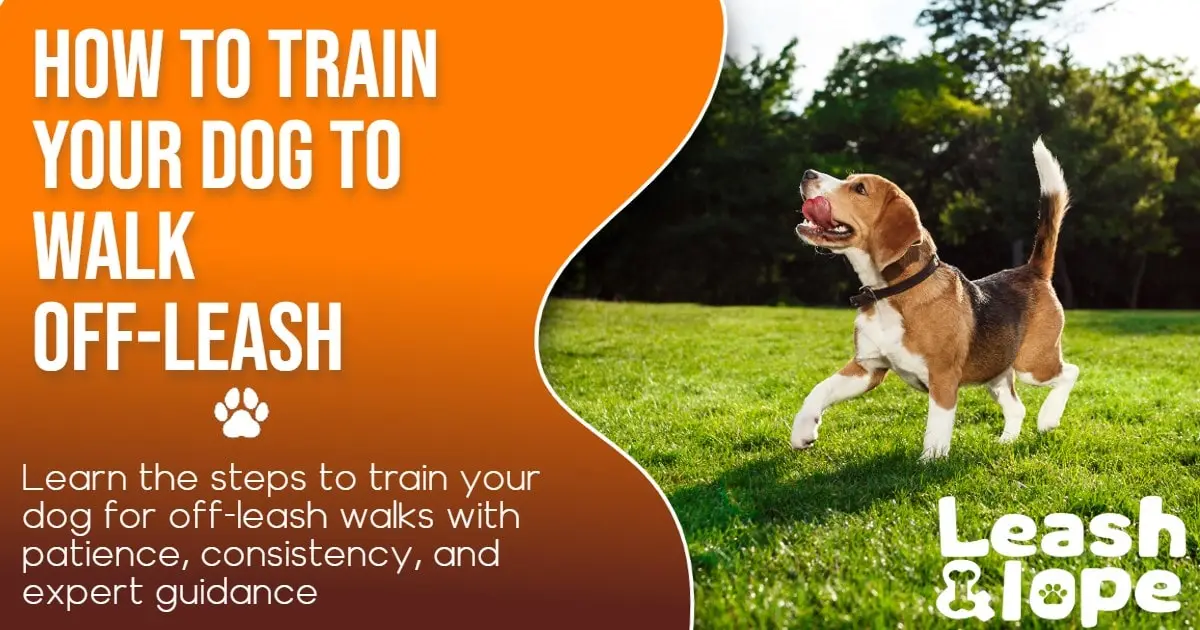Are you tired of walking your dog on a leash constantly? It is a great feeling to see your dog run without you. and, you are sitting watching your dog walk gracefully without a leash. Sounds like a dream? This ultimate article gives you an in-depth idea of how you can train your dog to walk off-leash.
Is Your Dog Ready?
First things first, is your dog ready to walk off-leash? I mean just imagine, what if you trust them and leave them without proper training? Yes! We all have the same worries. What if they lost? what if they start running and you won’t be able to chase them? what if they get injured?
These are the worries we all have in mind before and off-leash training. Here are some steps to help you determine if your dog is ready for off-leash:
1. Basic Command Training
Before starting off-leash training, make sure your dog knows basic commands like “sit,” “stay,” “come,” “heel,” and “leave it” while on a leash. If your dog is not following the basic commands. later in the article, we’ve taught you you can win the trust of your dog.
If they are doing well on the leash they might perform well on off-leash. Before going directly to off-leash you can practice lose leash first. you can control the leash whenever you want and your dog thinks I am off-leash.
2. Are They Performing Well On-Leash?
if your dog doesn’t constantly pull on the on-leash and walk smoothly with you. It is more likely they perform well on the off-leash too
3. Are they Comfortable around other dogs or people?
your buddy should not worried about other people. they should be well-socialized with other dogs and humans. in this way, they won’t start panicking and perform well on off-leash.
4. Are they distracted Easily by other birds or animals?
Is your dog still focusing on your commands when distracted? When off-leash dogs generally distract with other birds or other animals.
If they are still following your commands means your basic obedient training is on point. and, they are more likely to do well on off-leash.
5. Understand the Leash Laws
can you do off-leash in your area? please confirm first either are allowed to have off-leash training. you might be restricted from your dog walking freely because of any restriction from the local government or community.
to check if you are allowed to do this, you can check by searching the laws in your area, and contacting your local animal control or law enforcement authorities. check if your area has a dog dog-only park to stay away from any trouble.
5 Easy Steps to Train Your Dog to Walk Off-Leash
Following are the five steps that will help in train your dog to walk off-leash training:
- Building a bond of trust and obedience
- Starting with training on a leash in a safe place
- Starting the training off-leash in a safe place
- Increasing the exposure
- Working with patience and consistency
1. Building a bond of trust and obedience

Developing basic obedience with your dog is a great way to strengthen your relationship and ensure their safety.
To start, choose a quiet and distraction-free environment for training. Start by teaching your furry friend basic commands like “sit,” “stay,” and “come.” These commands will come in handy when you need to keep them close during walks. Use a clear, firm voice and pair it with a hand signal. Make sure you don’t sound too hard. Use positive reinforcement.
Find out what motivates your furry friend. Is it treats, belly rubs, or maybe a favorite toy? Once you know their preferred reward, use it to reinforce positive behaviors.
For example, when teaching “sit,” hold a treat above their head and say “sit” while gently pressing their backend down. Once they’re in the sitting position, reward them with treats, lots of praise, and whatever they like, in a safe manner.
Timing is crucial here – make sure to reward them immediately after they display the desired behavior so they can make the connection.
Keep training sessions short, fun, and consistent to maintain their interest. And don’t forget to celebrate their successes with belly rubs and treats! With time and practice, your doggo will become an obedience pro.
Play exciting games
There are many types of games you can play with your dog, such as hide-and-seek, fetch, and tug-of-war. See Creative Ways to Exercise Your Dog
A tired dog is a happy dog
These activities can help your dog develop trust with you when it comes to training them to walk off-leash. Also, They also strengthen your relationship and reinforce your role as a confident leader as well as a friend.
Avoid Punishment to Train Your Dog to Walk Off-Leash
It’s important to avoid certain punishing behaviors that can harm the trust-building process with your dog.
Physical punishment like hitting or kicking, yelling or shouting at them, using harsh training tools, or any form of intimidation can create fear and anxiety in your furry friend.
These actions can damage the bond between you and your dog, making it harder for them to trust and feel safe around you. Instead, focus on positive reinforcement, rewards, and clear communication to build trust and a loving relationship. Remember, a happy and trusting pup is a paw-some companion.
2. Starting the training on a leash in a safe place
As you’ve developed the basic bond of trust and obedience with your dog, it’s time to start the actual training.
Choosing the right location is crucial when training your dog off-leash. The location should be enclosed or have a fence to prevent your dog from running off. It should also be relatively quiet and free from all sorts of distractions.
This will help your dog stay focused on your commands without being distracted by other sounds or sights.
Begin the training on-leash in the start after choosing the right location but keep the leash relatively long. Attach a long leash to your dog’s collar or harness. This will give you control while allowing your dog some freedom to move around. Now use the recall technique.
Say your dog’s name in an enthusiastic and inviting tone. Make it sound exciting and rewarding, so they feel motivated to come to you, ensuring that you still sound soft and not too hard.
When your dog starts coming towards you, reward them with praise, treats, or their favorite toy. This is positive reinforcement, which is mainly developed while building the basic bonds of trust and companionship with your dog. It’ll help reinforce their behavior and make them more likely to respond to your recall command in the future.
As your dog becomes more reliable with recall, gradually increase the distance between you and them. Now you can introduce mild distractions like toys or other people to test their focus and obedience. Practice it regularly and be patient with your doggo.
3. Starting the training off-leash in a safe place
Now that you’ve trained your dog to respond to your commands on-leash, you can start the off-leash training. Again, choose a safe and controlled environment just like you did in the previous step. Start walking your dog on a leash till you both are relaxed and comfortable.
Now, allow your dog to walk off-leash but keep it for a shorter duration. Monitor your dog’s behavior and keep practicing the basic commands. Use treats or toys as rewards to reinforce positive behavior when they come back to you, as you practiced in the previous steps.
Once your dog is responding well to your commands, gradually increase the distance between you and your furry buddy. Starting with short distances and gradually working your way up while carefully taking care of everything will give you wonderful results.
4. Increasing The Exposure
Now, you can easily increase the exposure around your dog by introducing mild distractions and other dogs in a careful way. By increasing the exposure around your dog, you’ll help them get used to different environments and distractions.
It builds their confidence and teaches them to focus on you even when there are tempting things around. So, take them to new places, and introduce them to different sights, sounds, smells, other dogs, and different people. It’s like expanding their comfort zone one adventure at a time.
You can start by walking around the block or going to a local park. Observe their behavior and take precautions.
You should still take the leash with you even if your dog is walking off-leash so that in any disturbing case, you won’t have to panic.
5. Working with patience and Consistency
Patience and consistency are like the dynamic duo when it comes to training your dog to walk off-leash.
It takes time and effort to teach a dog a new skill, and they need to know that you are patient, understanding, and consistent in your approach. Be consistent in your commands, rewards, and expectations, and always be patient with your dog’s progress.
Every dog learns at their own pace, so you should not rush it. Be understanding throughout the process. It might take some time before your pup masters walking off-leash, but with your guidance and persistence, they’ll get there eventually. It is a universal principle. It may take several weeks or even months before you can trust your dog completely off the leash.
Just keep at it and celebrate every small victory along the way, be proud of yourself and your furry friend.
What if your Dog Starts to Run Away?
1. GPS Tracking Or a Name tag
To increase your chances of quickly locating your dog, consider using a GPS tracker. Knowing your dog’s real-time location can be a lifesaver in such situations. or at least have a name tag so if lost your neighbors can contact you.
2. Stay Calm
Dogs pick up on your emotions, so it’s crucial to stay calm and maintain your role as the pack leader (alpha dog). Use a firm, even-toned voice when calling your pup. Avoid sounding angry or fearful, as this can confuse your dog.
3. Stop Chasing
Resist the urge to chase after your dog, as this can turn it into a game for them. Your dog might think you’re playing and run faster. Instead, rely on your training and call them back using their recall command.
4. Show Treats
Let your dog see the treats you have in your pocket and even rustle the treat bag to get their attention. This visual and auditory cue can remind them of the rewards for coming back to you.
5. Turn Away
Turn your back to your dog and walk in the opposite direction while calling them using the recall command. This can pique their curiosity, making them more likely to come back to see what you’re doing.
Best Dog Breed for off-leash Training
To train your dog to walk off-leash, you need the best dog breed for it.
The best dog breeds for off-leash training are those that are known for their intelligence, trainability, and a strong desire to please their owners.
See the best dogs for running and hiking.
Keep in mind that individual temperament can vary within any breed, so it’s essential to consider the specific dog’s personality and needs. Here are some dog breeds that often excel in off-leash training:
- Labrador Retriever: Labs are highly trainable, obedient, and eager to please. They often excel in off-leash situations and enjoy being active outdoors.
- Golden Retriever: Similar to Labs, Golden Retrievers are intelligent and friendly, making them great candidates for off-leash training. They are also known for their reliability.
- Border Collie: Border Collies are exceptionally intelligent and thrive on mental and physical stimulation.
- German Shepherd: German Shepherds are known for their intelligence and loyalty. With proper training.
- Australian Shepherd: These dogs are highly trainable and excel in various dog sports and off-leash activities. They need both physical and mental exercise.
- Standard Poodle: Poodles are intelligent and eager to learn, making them excellent candidates for off-leash training. They also have the advantage of being hypoallergenic.
- Shetland Sheepdog: Shelties are known for their intelligence and agility. They can be excellent off-leash dogs with proper training and socialization
- Nova Scotia Duck Tolling Retriever: Tollers are intelligent and energetic dogs that often do well in off-leash activities, especially in water-related tasks.
- Australian Cattle Dog: These dogs are highly intelligent and responsive to training. They excel in off-leash work when properly exercised and mentally stimulated.
- Havanese: Havanese dogs are small but known for their intelligence and adaptability. They can excel in off-leash training for those looking for a smaller breed.
To wrap it up: Train Your Dog to Walk Off-Leash
The journey of being constantly tethered to a leash during your walks with your doggo will finally come to an end once you actively train your dog to walk off-leash.
Training your dog to walk without a leash is an exciting process that requires patience, consistency, and a whole lot of tail-wagging enthusiasm. By utilizing positive reinforcement techniques and building a strong foundation of trust, you can empower your furry companion to explore the world with freedom and confidence.
Celebrate every milestone along the way, whether it’s a perfectly executed recall or a focused loose leash walk. With time and effort, you’ll witness the joy of watching your pup explore the world by your side, free from the confines of a leash. and you finally can train your dog to walk off-leash
Are you ready to watch your doggos shine as they strut their stuff off-leash? I’m sure you are! So, grab those treats, put on your walking shoes, and embark on this adventure together. You’ve got this!

Dr. Haider is a general doctor with a unique level of connection to our four-legged friends. He is a valued contributor to our Website (Leash and Lope). Dedicated to providing accurate to dog owners in understanding and caring for their lovely pets.

